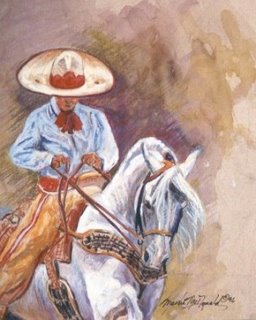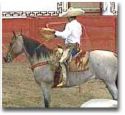

 Everybody thinks the cowboy is a uniquely American creation. Well that is not entirely true. Yes, it has evolved into something totally American but like just about everything else in this country it has its roots from another land.
Everybody thinks the cowboy is a uniquely American creation. Well that is not entirely true. Yes, it has evolved into something totally American but like just about everything else in this country it has its roots from another land. As you all know, Mexico had Texas long before we Americans did. Before that, Spain was in control of this land. The men that had first settled this land are the ones who brought the art of working cattle and taming horses. Americans did not start to settle here until 1821. Mexico had started to allow some Americans to come in and become citizens of Mexico.

Moses Austin was supposed to bring the first settlers but he became sick and later died so his son Stephen F. Austin began bringing the settlers and settling in central and east Texas. From 1821 until after the Civil War (1861-1865) there really was no American Cowboy. The people here in Texas at that particular time were just your typical pioneers and homesteaders just like you see in the old TV westerns.
The people who settled in Texas after 1866, for the most part, were poor farmers from the South. Most of these people had their homes and farms blown to bits from the Civil War. The main thing these people did with cows was milk them. As far as horses (and mules) go, they would either ride them for transportation or hitch them to a plow or buggy.

Once these people settled out west, especially in Texas, they saw all these wild longhorn cows running loose. They knew there was a new business to be tapped in to, but they didn’t yet know how to 'Cowboy.'


Enter the Charro; he is also known more commonly as a vaquero. A vaca is Spanish for cow, so vaquero literally translates into a “worker of cows”. Charro was sort of a nickname sort of the same way we call American cowboys 'punchers or waddies. The term 'buckaroo' is also a slang term for cowboys that has its origins in us white folk's inability to properly pronounce “va- ker-ooh”.

The Charro originates from Jalisco (which is where the Mariachi can also be traced back to in the mid 1800's) and Michoacan (where my in-laws happen to hail from), Mexico. This particular area of Mexico developed the traditional “cowboying techniques” that were eventually passed on to the Americans.
The charro participates in Las Charreadas, which is basically a Mexican rodeo. It is actually the national sport of Mexico. Most people, like me, would have guessed it was soccer or baseball. Anyway, the Charros are world renowned for their horsemanship.

Charros are also known for their colorful dress, known as trajes (trah hes). These costumes are what later e volved into the traditional Mariachi costumes. Anyone that knows Mexicans as well as I do, know that most of them have a flair for the dramatic, as you can see this tradition dates back many, many years.
volved into the traditional Mariachi costumes. Anyone that knows Mexicans as well as I do, know that most of them have a flair for the dramatic, as you can see this tradition dates back many, many years.
 volved into the traditional Mariachi costumes. Anyone that knows Mexicans as well as I do, know that most of them have a flair for the dramatic, as you can see this tradition dates back many, many years.
volved into the traditional Mariachi costumes. Anyone that knows Mexicans as well as I do, know that most of them have a flair for the dramatic, as you can see this tradition dates back many, many years.Personally I believe a lot of racism and hatred that some people hold against each other could be overcome just by learning about our history. The Texicans and the Mexicans have much more in common than not. They developed the Charro and gave us the Cowboy. Their Charros also developed into their version of the “singing cowboys” more specifically Mariachis. Our cowboys developed into colorful singers as well, which I described in last weeks article. They have had the Charreada and we developed the rodeo i n the 1880’s.
n the 1880’s.
 n the 1880’s.
n the 1880’s.Another little known fact about the Mexican cowboys is Los Kinenos. In the 1850’s, Richard King began buying up a lot of land in South Texas and turned it into the world famous King Ranch, which is one of the largest ranches in the world. It has over 825,000 acres, which makes it larger than the state of Rhode Island. In 1854, he traveled to a village in Mexico that had been pretty much wiped out by a drought and he hired the entire town to come to Texas and work for him on the ranch. They later became known as Los Kinenos or the king’s men. To this day the descendants of the original Kinenos are still working, living and thriving on one of the greatest ranches ever known.

So the next time your watching Lonesome Dove, or at a rodeo, or just working on your own ranch, give a tip of the old sombrero to our partners from south of the border.
God and Texas,
Jason Watson

Hi Jason,
ReplyDeleteWish I had seen the original, I would have given it a link with my own July 4 article. Mine would have been a good introduction to yours. I'm going to give an addendum to mine and link to this, if'n you don't mind. http://cowboy-bob.blogspot.com/2009/07/as-american-as-cowboy.html